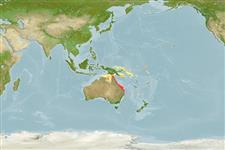>
Acanthuriformes (Surgeonfishes) >
Pomacanthidae (Angelfishes)
Etymology: Chaetodontoplus: Greek, chaite = hair + Greek, odous = teeth + Greek, plous, ous, oo = crossing (Ref. 45335).
Environment: milieu / climate zone / depth range / distribution range
Ecologia
marino associati a barriera corallina; non migratori; distribuzione batimetrica 10 - 50 m (Ref. 48391). Subtropical
Western Pacific: Queensland, Australia. Reported to range south to New South Wales and Lord Howe Island (Ref. 9710).
Size / Peso / Age
Maturity: Lm ? range ? - ? cm
Max length : 25.0 cm TL maschio/sesso non determinato; (Ref. 2334)
Short description
Morfologia | Morfometria
Spine dorsali (totale): 13; Raggi dorsali molli (totale): 17-19; Spine anali 3; Raggi anali molli: 17 - 19. Trunk black; the forehead, snout, breast, and caudal fin yellow; side of the head mostly blue with yellow spots; a wide white bar just behind the head, running from the below the forehead to the base of the pectoral fin; dorsal and anal fins with narrow yellowish to bluish white margin.
Inhabits coastal reefs and open bottoms with rock , coral, sponge, or seawhip outcrops to depths greater than 3 5 m (Ref. 9710). Juveniles often among sponges under jetties; adults often in pairs, generally in deeper water (Ref. 9710). Feeds on sponges and tunicates. Solitary or forms pairs or small groups. Occasionally exported through the aquarium trade (Ref. 48391).
Life cycle and mating behavior
Maturità | Riproduzione | Deposizione | Uova | Fecundity | Larve
Randall, J.E., G.R. Allen and R.C. Steene, 1990. Fishes of the Great Barrier Reef and Coral Sea. University of Hawaii Press, Honolulu, Hawaii. 506 p. (Ref. 2334)
IUCN Red List Status (Ref. 130435)
Threat to humans
Harmless
Human uses
Informazioni ulteriori
Nomi ComuniSinonimiMetabolismoPredatoriEcotossicologiaRiproduzioneMaturitàDeposizioneSpawning aggregationFecundityUovaEgg development
Age/SizeAccrescimentoLength-weightLength-lengthLength-frequenciesMorfometriaMorfologiaLarveDinamica popolazioni larvaliReclutamentoAbbondanzaBRUVS
BibliografiaAcquacolturaProfilo di acquacolturaVarietàGeneticaElectrophoresesEreditarietàMalattieElaborazioneNutrientsMass conversion
CollaboratoriImmaginiStamps, Coins Misc.SuoniCiguateraVelocitàModalità di nuotoArea branchialeOtolithsCervelliVista
Strumenti
Special reports
Download XML
Fonti Internet
Estimates based on models
Preferred temperature (Ref.
123201): 23.9 - 27.6, mean 26.1 °C (based on 78 cells).
Phylogenetic diversity index (Ref.
82804): PD
50 = 0.5000 [Uniqueness, from 0.5 = low to 2.0 = high].
Bayesian length-weight: a=0.03090 (0.01359 - 0.07026), b=2.89 (2.70 - 3.08), in cm total length, based on LWR estimates for this (Sub)family-body shape (Ref.
93245).
Trophic level (Ref.
69278): 3.0 ±0.00 se; based on food items.
Resilienza (Ref.
120179): Medio, tempo minimo di raddoppiamento della popolazione 1.4 - 4.4 anni (Preliminary K or Fecundity.).
Fishing Vulnerability (Ref.
59153): Low vulnerability (15 of 100).
Nutrients (Ref.
124155): Calcium = 35.9 [16.1, 68.0] mg/100g; Iron = 0.559 [0.324, 0.970] mg/100g; Protein = 19 [18, 20] %; Omega3 = 0.161 [0.092, 0.274] g/100g; Selenium = 14 [7, 29] μg/100g; VitaminA = 47.1 [12.0, 179.4] μg/100g; Zinc = 0.898 [0.572, 1.360] mg/100g (wet weight);
